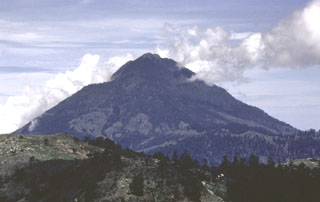Report on Tacana (Mexico-Guatemala) — September 1986
Scientific Event Alert Network Bulletin, vol. 11, no. 9 (September 1986)
Managing Editor: Lindsay McClelland.
Tacana (Mexico-Guatemala) New fumaroles above 8 May crater
Please cite this report as:
Global Volcanism Program, 1986. Report on Tacana (Mexico-Guatemala) (McClelland, L., ed.). Scientific Event Alert Network Bulletin, 11:9. Smithsonian Institution. https://doi.org/10.5479/si.GVP.SEAN198609-341130
Tacana
Mexico-Guatemala
15.132°N, 92.109°W; summit elev. 4064 m
All times are local (unless otherwise noted)
Geologists flew over Tacaná in early October. They noted that many small new fumaroles had formed in an area extending about 200 m above the level of the crater that formed on 8 May. The highest of the new fumaroles was also the largest, producing a white steam column 10-20 m high. The 8 May crater, at 3,400 m altitude (as measured by the aircraft altimeter) [but see 11:4], consisted of two vents about 8 and 12 m in diameter. Since May, the smaller vent has produced a white vapor column 200-300 m high. The larger vent was filled with water and had ceased emitting steam. Seismicity continued at a rather low level (similar to that of March). The geologists warned civil protection authorities from the state of Chiapas that unconsolidated material could form landslides when further loosened by the effect of the new fumaroles, and actions were being taken accordingly.
Geological Summary. Tacaná is a 4064-m-high composite stratovolcano that straddles the México/Guatemala border at the NW end of the Central American volcanic belt. The volcano rises 1800 m above deeply dissected plutonic and metamorphic terrain. Three large calderas breached to the south, and the elongated summit region is dominated by a series of lava domes intruded along a NE-SW trend. Volcanism has migrated to the SW, and a small adventive lava dome is located in the crater of the youngest volcano, San Antonio, on the upper SW flank. Viscous lava flow complexes are found on the north and south flanks, and lobate lahar deposits fill many valleys. Radial drainages on the Guatemalan side are deflected by surrounding mountains into the Pacific coastal plain on the SW side of the volcano. Historical activity has been restricted to mild phreatic eruptions, but more powerful explosive activity, including the production of pyroclastic flows, has occurred as recently as about 1950 years ago.
Information Contacts: S. de la Cruz-Reyna, UNAM, México D.F.

